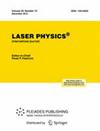无源 Q 开关掺铒光纤激光器的带宽调制和脉冲特性分析
IF 1.1
4区 物理与天体物理
Q4 OPTICS
引用次数: 0
摘要
我们展示了在无源 Q 开关掺铒光纤激光器中利用超窄可调谐带通滤波器(UNTBF)调制激光带宽的方法。利用碳纳米管作为可饱和吸收体,在 35.5 mW 的 Q 开关阈值下实现了无源 Q 开关机制。基于 UNTBF 引入的光谱滤波效应,在 75.9 mW 的固定泵浦功率下,3 dB 激光带宽可从 0.016 nm 调整到 0.478 nm。对每个不同带宽下的相应脉冲行为进行了表征,结果表明,脉冲宽度可以根据激光带宽从 7.8 μs 调整到 2.6 μs,这符合时间-带宽乘积规则。相应地,脉冲重复率和脉冲能量在整个激光带宽范围内分别从 16.23 kHz 到 26.16 kHz,从 0.67 μJ 到 1.03 μJ。在泵浦功率增加到 107.2 mW 时,对脉冲性能进行了进一步研究。据我们所知,这是首次在无源调 Q 光纤激光器中演示频谱带宽调制,有助于充分发挥调 Q 脉冲应用的可能性。本文章由计算机程序翻译,如有差异,请以英文原文为准。
Bandwidth modulation and pulse characterization of passively Q-switched erbium-doped fiber laser
We demonstrate the modulation of laser bandwidth by utilizing an ultranarrow tunable bandpass filter (UNTBF) in a passively Q-switched erbium-doped fiber laser. The passive Q-switch mechanism is enabled by using carbon nanotubes as saturable absorber at a Q-switched threshold of 35.5 mW. Based on spectral filtering effect introduced by the UNTBF, the 3 dB laser bandwidth can be tuned from 0.016 nm to 0.478 nm at a fixed pump power of 75.9 mW. The corresponding pulse behavior for each different bandwidth is characterized, and the results reveals that the pulse width can be as well tuned from 7.8 to 2.6 μ s against the laser bandwidth, which agrees with the rule of time-bandwidth product. Correspondingly, the pulse repetition rate and the pulse energy vary from 16.23 kHz to 26.16 kHz and from 0.67 to 1.03 μ J respectively across the laser bandwidth. Further investigation of the pulse performance is performed against the pump power increment up to 107.2 mW. To the best of our knowledge, this is the first demonstration of spectrum bandwidth modulation in a passively Q-switched fiber laser, which can be useful for fully exploiting the possibilities of Q-switched pulse applications.
求助全文
通过发布文献求助,成功后即可免费获取论文全文。
去求助
来源期刊

Laser Physics
物理-光学
CiteScore
2.60
自引率
8.30%
发文量
127
审稿时长
2.2 months
期刊介绍:
Laser Physics offers a comprehensive view of theoretical and experimental laser research and applications. Articles cover every aspect of modern laser physics and quantum electronics, emphasizing physical effects in various media (solid, gaseous, liquid) leading to the generation of laser radiation; peculiarities of propagation of laser radiation; problems involving impact of laser radiation on various substances and the emerging physical effects, including coherent ones; the applied use of lasers and laser spectroscopy; the processing and storage of information; and more.
The full list of subject areas covered is as follows:
-physics of lasers-
fibre optics and fibre lasers-
quantum optics and quantum information science-
ultrafast optics and strong-field physics-
nonlinear optics-
physics of cold trapped atoms-
laser methods in chemistry, biology, medicine and ecology-
laser spectroscopy-
novel laser materials and lasers-
optics of nanomaterials-
interaction of laser radiation with matter-
laser interaction with solids-
photonics
 求助内容:
求助内容: 应助结果提醒方式:
应助结果提醒方式:


